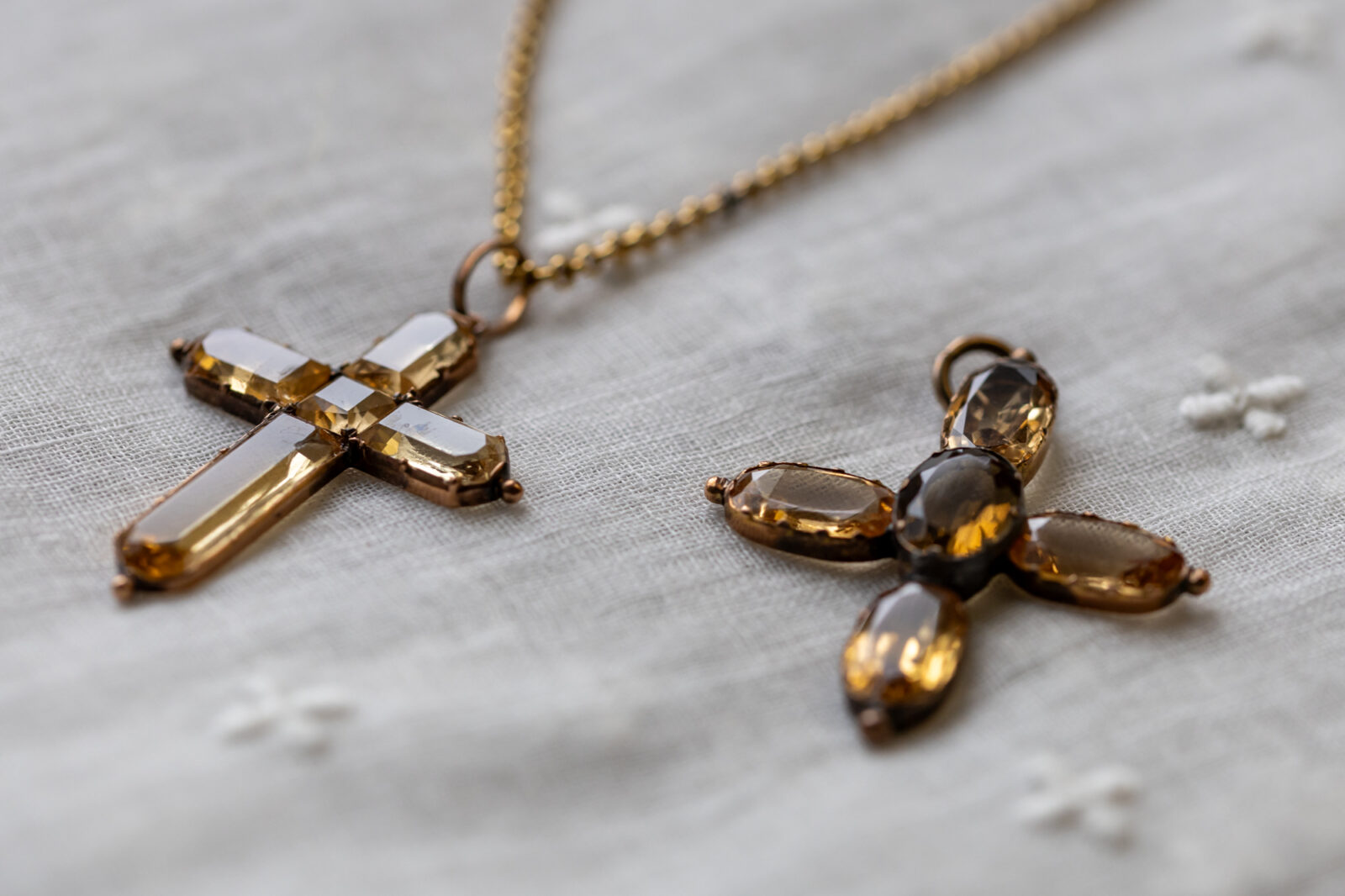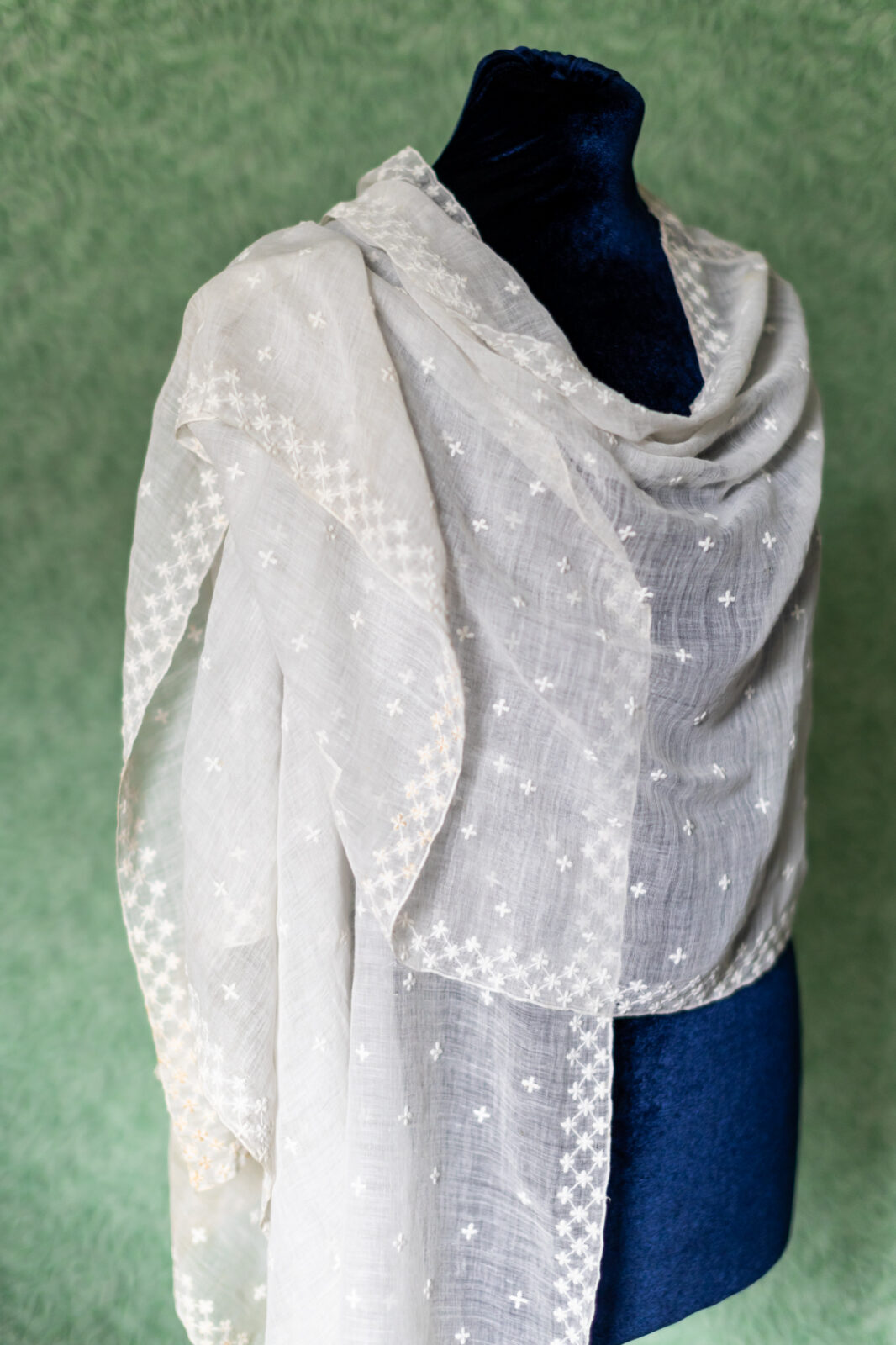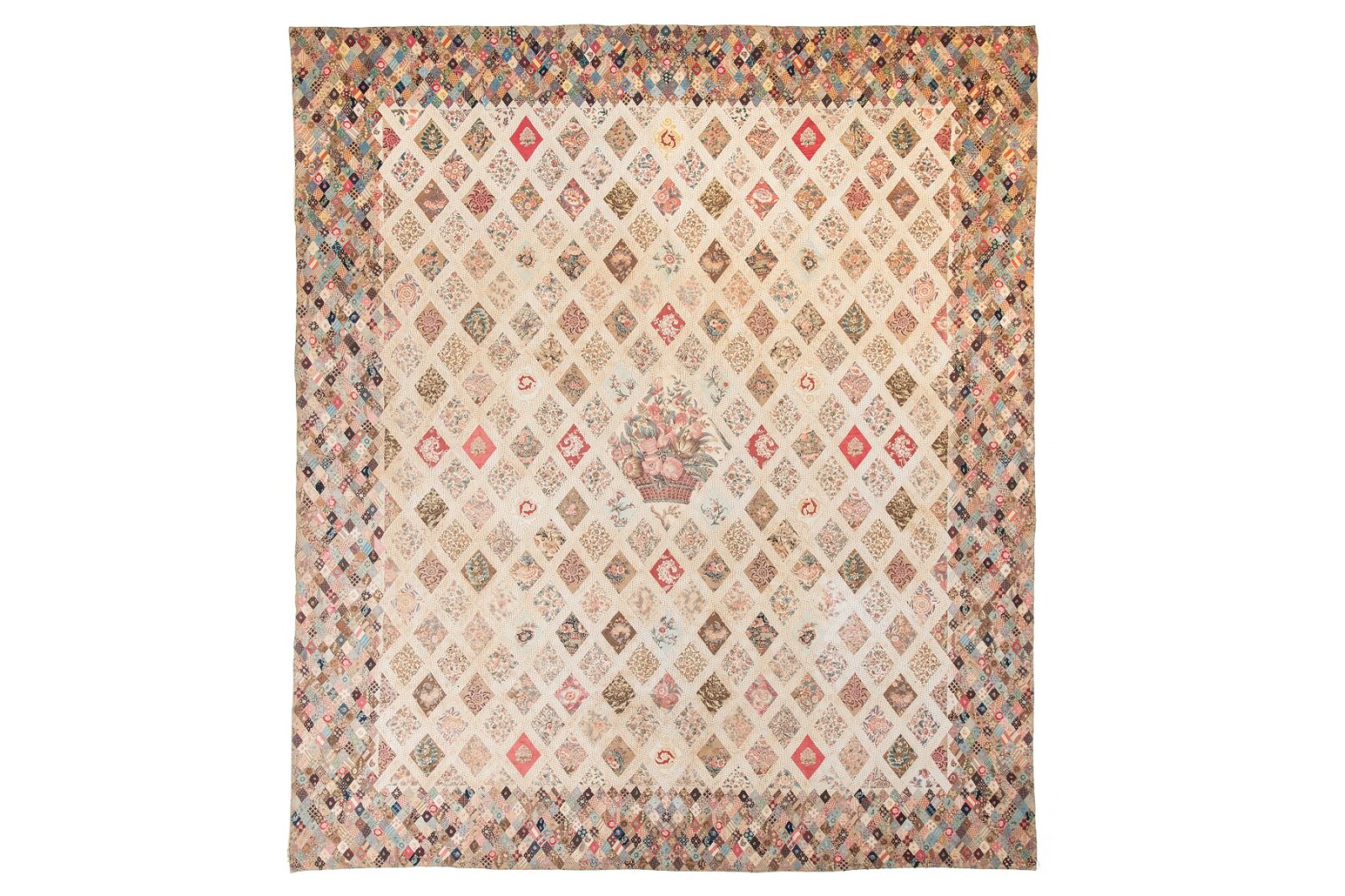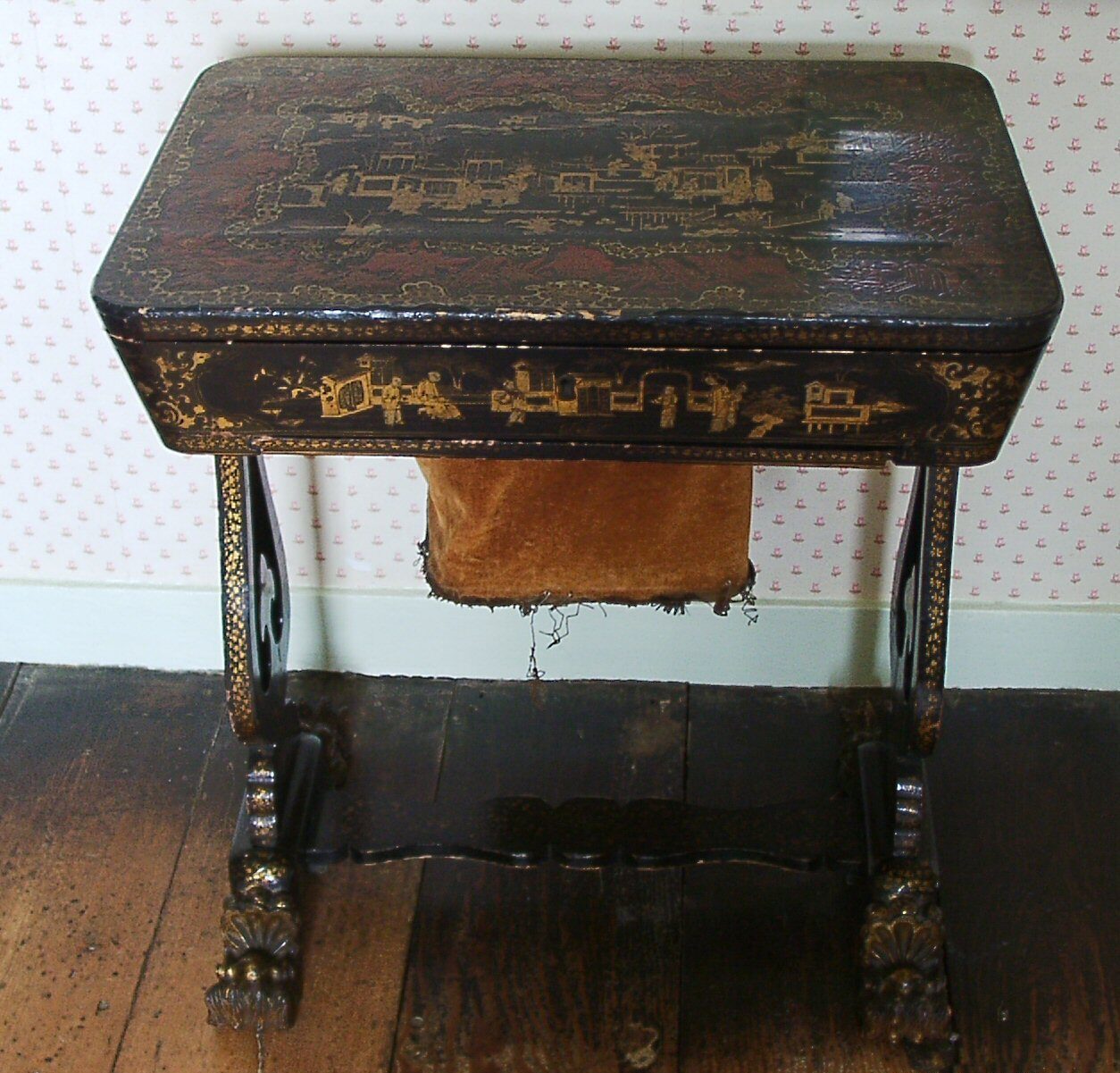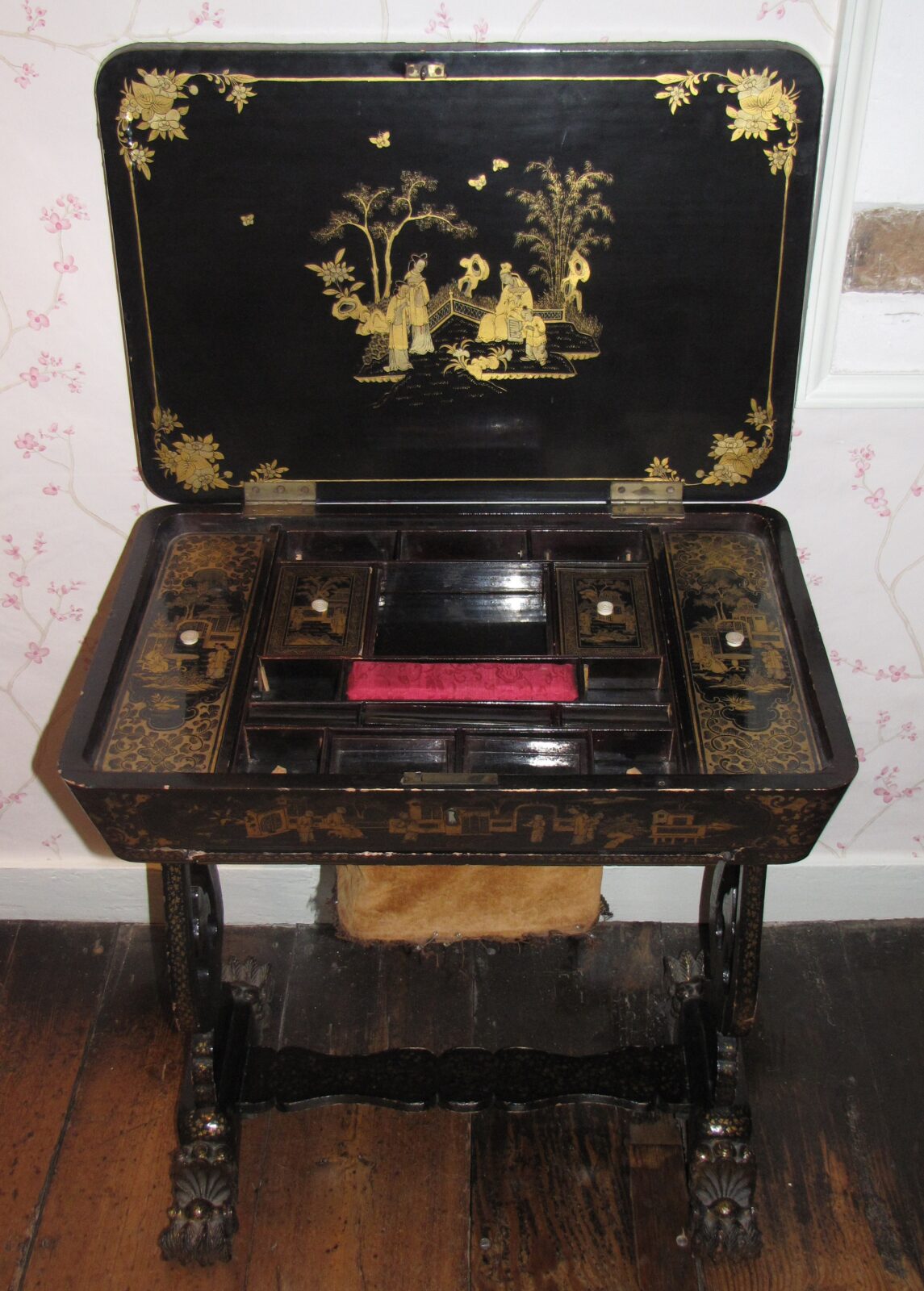Room 9: Global Objects
Indian Muslin shawl
This Indian muslin shawl is believed to have been worked by Jane Austen, who like most women of her time had practiced fine needlework since childhood. It was made by carefully joining together two panels of fine Indian muslin and then decorated with a pattern of embroidered crosses, worked in satin stitch.
In the late eighteenth-century, Indian muslin was a fashion staple for high society. Known as Dhaka muslin, it was imported by the East India Company from Dhaka city in what is now Bangladesh, then in Bengal. Handmade via a painstaking and elaborate process, from rare cotton that only grew along the banks of the holy Meghna river, the cloth was considered one of the great treasures of the age. Its export and fashionable status was enabled by a growing British involvement in the trade and internal conflicts of India.
In Mansfield Park, Lady Bertram wishes for an Indian shawl: ‘William must not forget my shawl if he goes to the East Indies… I wish he may go to the East Indies, that I may have my shawl. I think I will have two shawls, Fanny.”
Lady Bertram’s flippant wish that William should become involved in the complex and often violent conflicts in India, just so that she can gain a shawl, highlights her shallowness and selfishness. Jane criticises the lack of interest that high society showed in the fraught colonial contexts behind fashionable foreign items, and of Britain’s complex role in international trade.
Patchwork Coverlet
This patchwork coverlet was made by Jane, her sister and their mother, and probably begun around 1810.
It was made using the English paper method, in which fabric is cut out and stitched to paper shapes. They are then hand-stitched together, using tiny stitches (about 12 per inch), and the paper is then removed. There are 249 hand-stitched diamond pieces in the middle panel, and over 2,500 in the outer panel, representing hundreds of hours of work.
There are at least 64 different fabrics in the coverlet, but many were made from cotton. Cotton was grown on British colonies in India and the Caribbean but processed in British cities like Birmingham and Manchester. By the nineteenth-century, half of all the world’s cotton cloth was produced in Britain.
Despite the high supply of cotton in England, it was still a valuable material and scraps and offcuts were saved and carefully re-used. This coverlet is a clever example of how even the smallest scraps of fabric could be recycled. Another popular way was to use it as a protective lining to store jewellery or other valuable items, like the cotton Mary Crawford uses in Mansfield Park to protect her necklaces.
We don’t know exactly when the coverlet was completed, but we know the Austen women were still working on a quilt in May 1811. Jane reminded her sister Cassandra in a letter to ‘collect pieces for the patchwork – we are at a standstill.’ Cassandra was staying with their brother Edward on his estate in Kent at the time, where there would have been many spare fabric pieces available from the dressmaker, who made clothes for Edward’s 11 children.
Replica Pelisse
This is an exact replica of a pelisse believed to have belonged to Jane Austen. The original is now owned by Hampshire County Council and looked after by the Hampshire Cultural Trust. It is the only surviving dress item believed to have belonged to Jane Austen.
A pelisse is an ‘overdress’ or a ‘coat dress’ and would have been fitted closely to the figure. It gives us an idea of Jane’s height – here it is displayed on a child-size mannequin and is a size 4-6 in current UK women’s sizing. It indicates that Jane was approximately 5 feet 7 inches high (quite tall for a woman in her time). The original is thought to have been made in 1812.
Jane’s pelisse has clear signs of being made during a time of global conflict. At the time, Britain was one of several countries fighting to stop the expansion of the French Empire under Napoleon. France’s domain included nearly the entire European continent, as well as many colonies in Asia, Africa and the Americas.
Accordingly, the pelisse is made purely from English silk (the war with France meant that French silk imports were banned). ‘English’ silk was manufactured in English mills but used raw silk imported from Turkey, Italy or the East. Further, the pelisse is decorated with a pattern of oak leaves – a popular patriotic motif representing the wooden ships of the British Navy. Jane may have worn it as a visual expression of her support for her brothers Charles and Frank, who were both on active military duty between 1812 – 1814.
An item of clothing made entirely of silk was an expensive item to own during wartime. In Mansfield Park, Fanny is scorned because “she neither played on the pianoforte nor wore fine pelisses.” By contrast, Austen had at least two, and mentions a ‘trimmed’ pelisse in addition to the silk one in her letters.
Chinese Work-table
This black lacquer work-table is believed to have belonged to Jane Austen. The top, painted in gilt with figures and pavilions, can be opened to reveal a fitted interior with lidded cannisters for storing needles, thread and other sewing items, and a work basket below.
The table dates from the early nineteenth century and was exported from Qing dynasty China. Although we don’t know exactly where it was made, most tables like this were shipped from Canton (now Guangzhou) and produced specifically for export to Europe.
Its journey to England was likely managed through the British East India Company, which served as a trading body for English merchants at this time. The Company, as it was known, held a monopoly on British trade with the East, which included lucrative products such as tea, spices, porcelain, silver and opium. They also participated in the slave-trade, trafficking enslaved people from Africa to work on plantations in India and Indonesia.
A work-table like this would have been a commonplace object in a fashionable nineteenth century household. Sewing was an extremely important part of women’s lives and most women, regardless of status, would have spent a lot of their time at their ‘work’, either for leisure, profit or charity. Jane Austen was an excellent needleworker, and so was Fanny Price in Mansfield Park. In one scene, Lady Bertram naps while Fanny does the difficult parts of her sewing for her.
